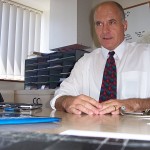Tales of a Medicine-Watcher are true stories from 50 years in medicine. Names and dates changed, staff names real (unless otherwise noted). The term Medicine-Watcher is used in The Youngest Science, the autobiography of Lewis Thomas, which I use with respect.
“What do you reckon this is?” I stared at the slightly irregular, rounded ball of tissue, about 4cm diameter, which Dr Jack Spence (not his real name) held in a small pot of formalin. The surgical notes stated it had been removed from a lung. I shook my head. Dr Spence gingerly pulled out the lump, squeezed it gently, then threw it firmly on the laboratory floor.
It bounced back up and nearly hit the ceiling. Exactly like a superball. Superballs had been invented as toys a decade earlier, and were a fad for about two years. Made of a synthetic polymer, they always bounced to twice or three times the thrown height. “It’s an adenochondroma” he said, as he caught it on the way down. I just looked at him, unbelieving. Microscopy confirmed it. Yep, an adenochondroma.
Jack Spence was an anatomical pathologist at a large teaching hospital in Melbourne. I started there as a pathology trainee in 1975. I was 27. He was a terrific pathologist, a very good administrator, an excellent teacher, and a thoroughly nice bloke. I had started three months earlier, and a junior trainee would perform the autopsies, attend the dissection of surgical specimens (known as the cut-up), view them under the microscope two days later with one of the pathologists, and attend all pathology reviews with the clinicians. Jack had a good sense of humour, liked a laugh, and enjoyed seeing the expression on my face that day.
Adenochondromas are benign tumours of the lung, not uncommon, made predominantly of cartilage. Cartilage is very bouncy, especially when shaped a a ball.
Three years later, in 1978, my training post had moved to Preston and Northcote Community Hospital (known as PANCH), a very busy suburban hospital. I needed to do a year of general pathology, such as blood and microbiology tests, as well as tissue diagnosis. Well, I was sitting in the lab doing the cut-up with the pathologist. Dr John Francis Xavier Murphy was a lovely older pathologist, very experienced, not academic, very old school (think 1930s). His bookcase had a shelf on Irish History, all of which I read, and this endeared me to Ireland forever. He pulled out a roundish lump, like a ball, from the pot, and muttered “From a lung. I wonder what it is”.
I took the specimen from his hand, squeezed it gently, threw it on the floor, it hit the ceiling, and bounced a few more times before we caught it. “It’s an adenochondroma” I said proudly. Unbeknownst to me, Dr Murphy had never seen this manoeuvre before. I thought he was going to die. His mouth remained open and his face paled and trembled, and he held on to the lab bench and told me in short clipped sentences what he would do to me I ever performed that idiocy again. And two days later when we confirmed the microscopy as an adenochondroma, he repeated his threats.
He was, of course, correct. I saw several more adenochondromas in my pathology career, but never treated them like a superball again. But I remember Jack Spence fondly. It was, after all, the seventies.
Success is how high you bounce when you hit bottom – George S. Patton

